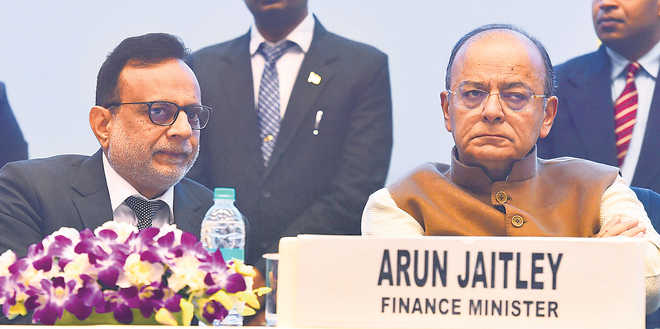
Budget 2018-19: FM Jaitley will have to do some tight-rope fiscal walking.
Mythili Bhusnurmath
WITH just a day to go for Finance Minister Arun Jaitley’s fifth and the BJP government’s last full Budget before the 2019 general election, the otherwise relatively humdrum measure of macroeconomic health, the fiscal deficit (FD), has shot into prominence. The bet is on whether the government will opt to walk the straight and narrow on fiscal matters (read, stick to the target for FD; 3.2 per cent of GDP) — laid down in the last Budget, or whether politics will override economics and the FD target will be breached; as is the wont in pre-election years.
For now, the BJP government seems to be standing its ground on the FD, measured as the excess of government expenditure over non-debt receipts. Despite mounting evidence that growth continues to be anaemic, employment generation is nowhere near where it should be and private sector investment is not picking up, it seems determined to adhere to the roadmap laid out in Budget 2017-18. Nonetheless, as it nears the end of its five-year term and signs of both rural distress and voter impatience gather pace, the odds are that politics might just override economics. Rating agencies be damned.
What does this mean for Budget formulation? Finance Minister Jaitley has already indicated his priorities. Speaking at a recent event in Mumbai, he was emphatic that agriculture is top priority for his government: economic growth is not ‘justifiable and equitable’ unless the benefits are ‘clear and evident’ in the farm sector. The question is: How is the government going to ensure there are clear and evident benefits in the farm sector?
Even if a substantial part of the answer lies in improving the quality of spending and root-and-branch reform in agriculture, and not so much in spending more, the fact is the government will need to increase its outlay for the sector. The Ashok Dalwai committee set up by government to examine ways of doubling farmers’ income by 2022, a promise made in Budget 2016-17, estimates that the government would need to spend an additional Rs 6,40,000 crore to deliver on its promise. Where is it going to find these resources in a scenario where revenues, especially indirect tax revenues, show no sign of picking up and expenditure is hard to rein in; if the fiscal deficit is taken as cast in stone?
Of course, it could resort to that ultimate ploy of all governments faced with an inflexible fiscal target; dodgy accounting. Under former FM, P Chidambaram, the UPA government resorted to this strategy; with considerable success in the short-run, but with disastrous consequences for the longer term. However, there are limits to dodgy accounting and the BJP government, to its credit, has largely refrained from going down this path so far. And that leaves Jaitley with just three choices — get more revenue, cut back on expenditure, or run a higher fiscal deficit.
Take the first: Get more revenue. This is a tall order going by the way collections under the GST have dipped with each successive month after the tax was introduced in July 2017. On the non-tax front, yes we could hope to garner more, especially if the good performance on disinvestment in the current fiscal can be replicated next year. But it is a big ‘if’.
On the expenditure front, again, the FM’s options are limited. Unfortunately, the bulk of government expenditure is on items like salaries and pensions, interest payments and so on, all of which is non-negotiable. The only area where he has some elbow room is capital expenditure. But that is precisely the last place where he should cut back, given how private sector investment is at a five-year low, leaving the government with no alternative but to step into the breach and shore up overall investment.
In a scenario where it is difficult to increase revenue and it is not desirable to cut back on expenditure, the government is left with just one choice — stop treating the fiscal deficit as cast in stone. Use the flexibility given in the NK Singh committee report — 0.5 percentage point deviation in FD whenever structural reforms of far-reaching consequences for growth are undertaken — and spend on much-needed infrastructure that could crowd-in rather than crowd-out private investment. Even if it means falling marginally short of the target laid out in the medium-term fiscal roadmap.
Unfortunately, this apparently obvious solution seems to raise the hackles of fiscal zealots strongly influenced by Western (read, the US) school of thought. The Washington consensus might have been discredited but its ghosts still lurk in the shadows. So at one end, you have one school of economists urging the government to stick to its medium-term fiscal roadmap (3 per cent of GDP in FY19), regardless of the cataclysmic events witnessed in fiscal 2017-18. At the other, you have the opposite school urging fiscal expansion as a temporary salve to boost growth at a time when private investment is still fighting shy.
Given the imperative need to foster faster economic growth and employment creation, the choice should be a no-brainer. Sound macroeconomic policy should always be counter-cyclical. Remember policy makers have only two macroeconomic tools at their command — fiscal and monetary. In a globalised world, monetary policy is significantly impacted by global factors. With most Central banks on a tightening cycle, it would be unwise for the RBI to loosen monetary policy. Fiscal policy, in contrast, is less influenced by external factors. Jaitley must, therefore, take the bull by the horns and budget for a slight easing of the FD target.
This is not an argument for fiscal profligacy as much as an argument for fiscal pragmatism. Remember, it will be a while before GST stabilises so though revenues are likely to rise in the medium to longer term, lower GDP growth is bound to impact tax collections adversely. According to advance estimates by the Central Statistical Organisation, GDP growth in 2017-18 is likely to drop to 9.5 per cent as against the Budget estimate of 11.75 per cent. In such a scenario, an expenditure cut could prove counterproductive and might dampen growth further. Budget 2018-19 is a rare instance when the government’s political and the country’s economic interests coincide.
The writer is a senior consultant at National Council of Applied Economic Research



























